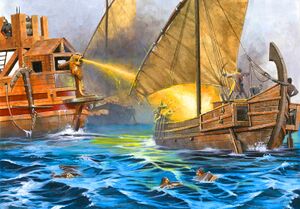Symmerian Fire
Makedonian Fire was an incendiary weapon utilized by the Makedonian Empire beginning in the 7th Century. The origin of the weapon is uncertain, and details of its composition were a closely guarded state secret of the Empire, lost in 1305 when it was conquered by the Arkoennites. Modern researchers generally are of the opinion the substance was a combination of various materials such as quicklime and sulfure, with some historians suggesting it was a primitive form of napalm. The term "Makedonian Fire" was not used by the Makedonians themselves, who identified it as "sea fire" (thalassion).
Makedonian Fire was typically employed by ships through the use of pressurized nozzles and siphons, not unlike modern flamethrowers. Designated "fire ships" were armed with the liquid and closed with enemy vessels to spew forth flames, which would not be extinguished by water. This proved invaluable in combat on the open sea, where wooden ships were especially vulnerable to fire and without the threat of being extinguished by sea water.
The origin of the substance is uncertain. It is believed that study into usage of incendiary weapons at sea was triggered by the fighting of the First Sabrian War, where the Makedonian Navy had struggled to compete with the fleets of the Sabrian Empire. Unable to match the Sabrians ship for ship, the Makedonians turned to chemistry and technology to compensate for their shortcomings. When and where Makedonian Fire was first introduced is not known with complete certainty, but is recorded being used against Sabrian fleets off the coast of Knichus in 681 CE. The effectiveness of the weapon proved instrumental in the Makedonians acheiving temporary control of the Strait of Lirinya during the Second Sabrian War, allowing the Makedonians to sail across the Strait and invade the Sabrian-Controlled island, though it would not prevent the Makedonian failure to capture it.
The weapon saw little use after the Sabrian Wars, owing to a lack of major naval powers to contest with the Makedonians. Viking longboats from Æþurheim were occasionally challenged with Makedonian Fire ships, but usage of the weapon was limited owing to the primary enemies of the Empire's decline being land-based adversaries. Relatively few Makedonian sources give detailed accounts of it, leaving modern historians largely in the dark regarding its specifications and actual service history. Despite its capability, its limitations were noted by the Makedonians themselves who commented that the weapon could only be used in good weather and had a limited range, forcing fire ships to close with enemy vessels and engage from a short distance. The Makedonians also noted that the weapon became noticeably less effective against the Sabrians as they adapted to its usage, both by keeping most of their ships out of range of fire ships while also coating their vessels with hides soaked in vinegar and fire retardent materials.
